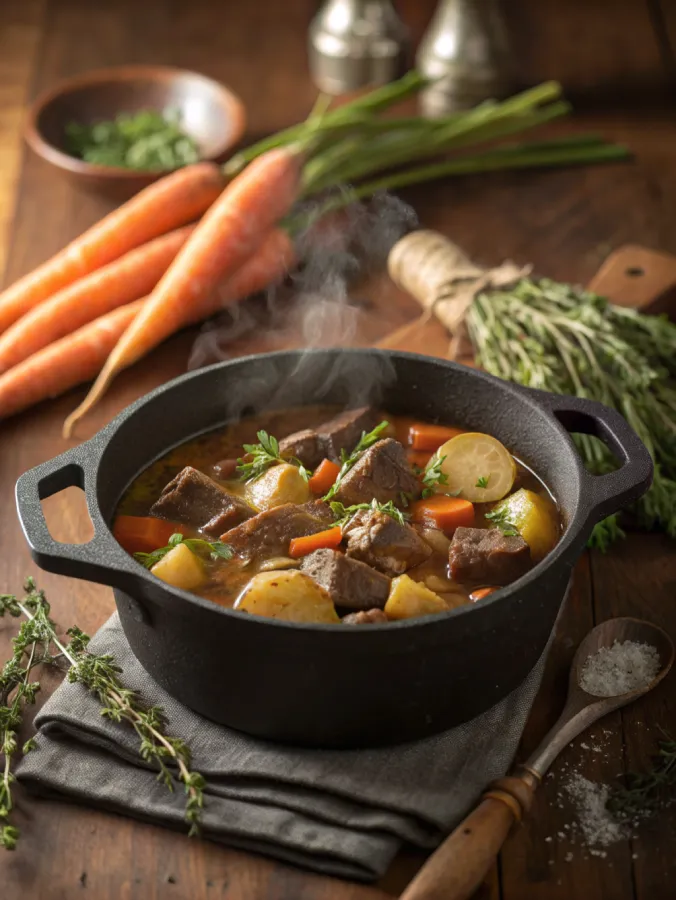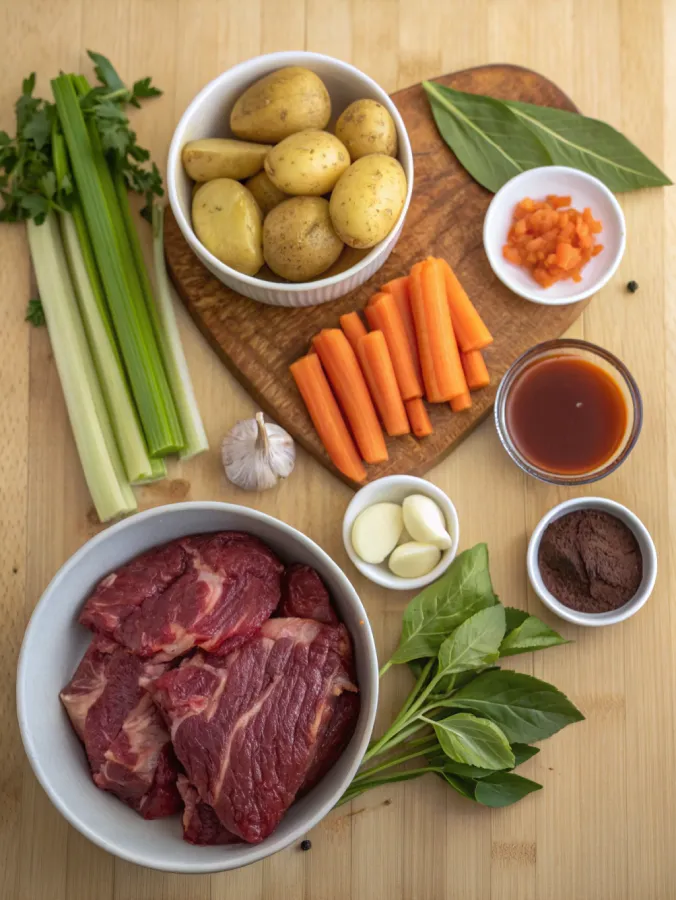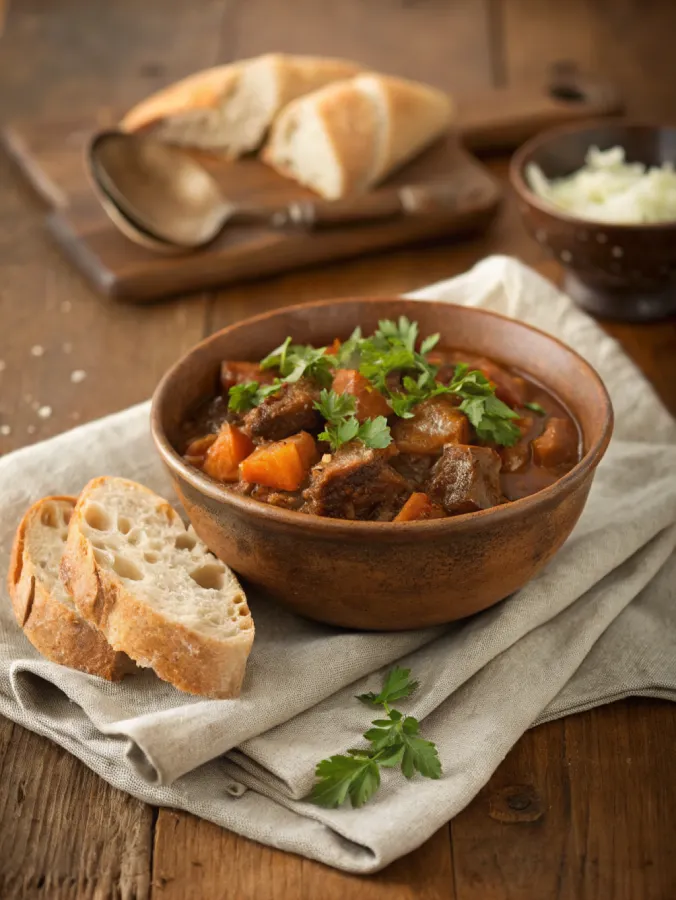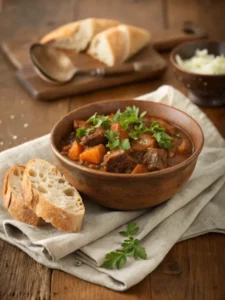
Beef stew recipe lovers, this one’s for you. If you’ve been searching for a hearty, flavor-packed meal that’s both nostalgic and nourishing, you’re in the right place. This classic dish delivers melt-in-your-mouth beef, rich broth, and perfectly tender vegetables, without needing fancy ingredients or techniques. Whether you’re cooking for family or stocking the freezer, this recipe brings comfort and confidence to your kitchen. Inspired by years of trial and error in my cozy North Carolina home, it’s the kind of meal that fills your house with warmth and your plate with soul.
In this Article
Key Takeaways: What You Need to Know
- Tender beef and hearty veggies in a rich, deeply flavored broth
- This beef stew recipe skips shortcuts and delivers pure comfort
- Perfect for meal prep, freezer-friendly, and no wine required if needed
- Detailed instructions, smart tips, and real-life flavor secrets
Why This Beef Stew Recipe Deserves a Spot in Your Weekly Rotation
A good beef stew recipe does more than feed you, it wraps you in warmth. From the first savory spoonful, you know you’re eating something made with intention. This isn’t just another throw-it-in-the-pot meal. Every step, from searing the meat to simmering the broth, builds layers of flavor that make each bite memorable.
The beef is fall-apart tender thanks to low, slow cooking, and the vegetables? They’re not mush. They’re perfectly cooked, adding sweetness, earthiness, and a touch of texture to balance the richness of the sauce. You don’t need wine (but you can use it), and there’s room to customize based on what’s in your pantry.
When you serve this beef stew recipe, it feels like a big warm hug. It’s a meal made for slowing down, sitting around the table, and savoring the moment.
A Crock Pot Vibe with More Depth
If you’ve enjoyed recipes like my ground beef crock pot recipes or even the classic chuck roast crock pot, then you’ll love this. It delivers all the slow-cooked goodness, but with a richer flavor and more intentional layering.
The deep, umami-packed broth comes together using pantry staples like tomato paste, soy sauce, and even a touch of Worcestershire. This combination helps the beef shine, without overpowering the natural richness of the meat. Whether you’re a seasoned home cook or just finding your way, this recipe is approachable, adaptable, and absolutely satisfying.
The Essential Ingredients for a Flavor-Packed Beef Stew Recipe

A great beef stew recipe starts with smart choices, especially when it comes to beef and broth. You don’t need anything fancy, but the right ingredients will take your stew from decent to unforgettable.
The Best Cut of Beef for Stew
Forget pre-cut “stew meat.” It’s often a mix of unknown cuts and inconsistent textures. For the best results, choose boneless beef chuck roast. It’s affordable, marbled with just enough fat, and breaks down beautifully into tender, flavorful chunks after a long simmer.
If chuck isn’t available, try bottom round or brisket. But steer clear of lean cuts like sirloin, they dry out too quickly. When in doubt, think about dishes like London broil crock pot: they rely on longer cook times and marbled cuts to shine. This stew is no different.
Cut your beef into 1.5 to 2-inch pieces after searing, not before. This keeps the beef juicy and prevents overcooking during browning.
Vegetables, Broth & Flavor Boosters
Vegetables aren’t just filler, they build depth. Go for Yukon Gold potatoes, which hold their shape and offer a buttery texture. Carrots and celery bring sweetness and aroma, while mushrooms (optional) add umami richness.
For the broth, skip store-bought beef stock. Use low-sodium chicken stock instead, it has a cleaner taste and lets the beef shine. You’ll boost it with tomato paste, soy sauce, and a splash of Worcestershire sauce. This trio creates layers of umami that transform the stew base.
Optional additions like anchovy paste or a pinch of gelatin can further improve texture and depth. Just like in slow cooker ground beef stroganoff, building from a flavorful base is key.
How to Make This Beef Stew Recipe Step-by-Step
Making this beef stew recipe doesn’t require special tools, just attention to a few key steps. The goal is simple: lock in flavor early, build depth slowly, and finish with a stew that tastes like it cooked all day (because it did).
Step 1: Sear the Beef Properly
Start by heating a heavy-bottomed pot or Dutch oven over medium-high heat. Add a splash of oil, then sear your beef in batches. Don’t overcrowd the pan, you want a dark crust on all sides. Once seared, remove the beef and set it aside. This step is where you build the base flavor.
If you’ve ever made crock pot French onion meatloaf, you know how much browning deepens flavor. It’s no different here.
Step 2: Sauté Aromatics
In the same pot, lower the heat and add diced onions, carrots, and celery. Cook until softened, about 5–7 minutes. Add garlic, tomato paste, and cook another minute. Deglaze the pot with a splash of red wine or stock, scraping up all the tasty browned bits.
Step 3: Build the Broth
Return the beef to the pot. Pour in chicken stock until it just covers the ingredients. Stir in soy sauce, Worcestershire, and bay leaves. If using, add a teaspoon of gelatin or a splash of balsamic vinegar for extra richness.
Step 4: Low and Slow
Bring to a gentle simmer, cover, and cook for 2–2.5 hours on the stovetop or in a 300°F oven. This slow cooking turns tough beef tender and coaxes maximum flavor from the broth.
Step 5: Add Vegetables in Stages
Add potatoes and optional mushrooms in the last 45 minutes. This timing prevents them from turning mushy. For peas or green beans, stir them in 10 minutes before serving so they stay vibrant.
Recipes like crock pot creamy potato and hamburger soup show how important it is to add veggies thoughtfully.
Step 6: Thicken and Finish
If the stew needs thickening, remove the lid for the last 20–30 minutes to let it reduce. Or, mash a few potato pieces into the broth. Skip the flour, this method keeps flavors clean and textures natural.
Beef Stew Recipe Tips That Actually Work
When it comes to a satisfying beef stew recipe, small details can make a big difference. These tips come from years of trial, error, and lots of delicious bowls.
Tip 1: Choose Stock Wisely
Many home cooks reach for store-bought beef broth, but it’s often too salty or flat. A better option? Low-sodium chicken stock with flavor boosters like soy sauce and Worcestershire. It gives your stew a clean, savory base while letting the beef shine.
Bonus: Add a teaspoon of powdered gelatin to mimic the richness of homemade stock. This is the same approach used in slow-cooked favorites like corned beef in crock pot for added body.
Tip 2: Avoid Flour for Thickening
Forget about flour or cornstarch slurry. The best beef stew thickens naturally. You can reduce the broth with the lid off or mash a few potatoes into the liquid. This gives the stew a velvety texture without altering the flavor or making it gluey.
Tip 3: No Wine? No Problem
Plenty of classic recipes call for wine, but you can get just as much flavor without it. Use extra stock, a splash of balsamic vinegar, or even some mushroom umami powder. The result is just as deep and satisfying, perfect if you’re avoiding alcohol.
I use this method in recipes like crock pot chili, where bold flavor doesn’t rely on wine, it’s all about layering.
Tip 4: Cook Veggies Separately If Needed
If you’re making a large batch to freeze, skip the potatoes or cook them separately. Potatoes can become grainy after freezing. Add them fresh when reheating or swap in grains like farro or serve over mashed cauliflower.

Beef Stew Recipe
Ingredients
Equipment
Method
- Cut the beef into large chunks if not already done.
- Heat olive oil in a Dutch oven over medium-high heat. Sear the beef in batches until browned on all sides. Set aside.
- In the same pot, add chopped onion, carrots, and celery. Cook for 5–7 minutes until softened.
- Add minced garlic and tomato paste. Stir for 1 minute.
- Deglaze the pot with a splash of chicken stock, scraping up any browned bits.
- Return the beef to the pot. Pour in the remaining stock.
- Add soy sauce, Worcestershire, and bay leaf. Stir well.
- Bring to a gentle simmer, then cover and cook for 2 hours (or place in oven at 300°F).
- Add potatoes, cover, and cook 45 minutes longer.
- Uncover and simmer an additional 20 minutes if you want a thicker broth.
- Remove bay leaf. Season with salt and pepper to taste.
- Let stew rest for 10 minutes before serving.
Nutrition
Notes
Tried this recipe?
Let us know how it was!How to Serve and Store This Beef Stew Recipe the Right Way

Now that your beef stew recipe is done simmering and filling your kitchen with rich, savory aroma, it’s time to serve it like a pro and make sure every spoonful counts, even the leftovers.
The Best Ways to Serve Beef Stew
A truly satisfying beef stew recipe deserves thoughtful pairings. Serve it with warm crusty bread for dipping into that thick, umami-rich broth. Or ladle it generously over buttery mashed potatoes or creamy polenta for the ultimate cold-weather comfort.
Egg noodles, rice, or roasted vegetables also pair beautifully. Add a fresh element like green beans or a crisp salad to balance the richness. That contrast brings everything together.
This stew is as comforting as my garlic butter steak bites and just as hearty as beef tips in the crock pot, but it stands out thanks to its deep, slow-cooked flavor.
How to Store and Reheat This Beef Stew Recipe
One of the best things about this beef stew recipe is how well it stores. In fact, it tastes even better the next day as the flavors meld and deepen.
Refrigerate leftovers in airtight containers for up to 4 days. For longer storage, freeze portions in freezer-safe containers for up to 3 months. Be sure to leave space at the top for expansion.
To reheat, warm gently on the stove over medium heat. Add a splash of broth or water if the stew thickens too much. Avoid microwaving large amounts, as it can dry out the beef or break the texture of the sauce.
Every time you reheat this beef stew recipe, it should taste just as good as the first night, maybe even better.
FAQs: Beef Stew Recipe Questions You’ve Been Asking
Can you make beef stew ahead of time?
Yes, and you should! Beef stew tastes even better the next day. The flavors deepen as it sits, and the texture improves. After cooking, let the stew cool slightly, then refrigerate in an airtight container. Reheat gently on the stove to preserve the richness.
According to USDA food safety guidelines, cooked stews can be safely stored in the fridge for up to 4 days.
Can you freeze beef stew?
Absolutely. Beef stew freezes well, especially if you skip the potatoes or add them fresh later. To freeze, portion into freezer-safe containers, leaving room for expansion. It keeps well for up to 3 months. Reheat from thawed on the stove or microwave.
Avoid freezing in glass jars unless they’re freezer-safe. For more safety tips, consult the USDA freezing guide.
What’s the best kind of beef for beef stew?
Boneless beef chuck roast is the top choice. It’s marbled, affordable, and tenderizes beautifully with low, slow cooking. Avoid lean cuts like sirloin, they dry out. This advice aligns with traditional beef stew standards found across cultures and cookbooks.
You can also use brisket or bottom round, but expect longer cook times.
How do you thicken stew?
The best methods don’t involve flour. Instead:
Reduce the liquid with the lid off
Mash some of the potatoes into the broth
Stir in a slurry of cornstarch only if you’re short on time
These methods retain flavor and texture naturally, avoiding a starchy or gummy feel.
Beef Stew Tips
Sear the beef in small batches for the best crust
Add veggies in stages to avoid overcooking
Use soy sauce or anchovy paste to add umami depth
Let the stew rest before serving, it improves flavor
Make extraz, it freezes beautifully
Conclusion: Why This Beef Stew Recipe Belongs in Your Rotation
If there’s one dish that truly defines cold-weather comfort, it’s a hearty beef stew recipe. This one brings together tender chunks of beef, deep layers of flavor, and vegetables that stay perfectly cooked, not mushy. It’s the kind of meal that fills your kitchen with warmth, your table with smiles, and your fridge with leftovers that taste even better the next day.
Whether you’re prepping for a family dinner, stocking the freezer, or just craving something soul-satisfying, this beef stew recipe delivers every single time. It’s forgiving, flexible, and built for real life, even if you skip the wine, change the veggies, or use chicken stock instead of beef.
And the best part? You don’t need chef skills to master it. Just patience, good ingredients, and a bit of care. This beef stew recipe is one you’ll return to again and again, just like I did when I first started cooking in that little kitchen outside Asheville.
So next time you’re standing at the stove, ladle in hand, remember: every great beef stew recipe starts with a story, and this one can be part of yours.


